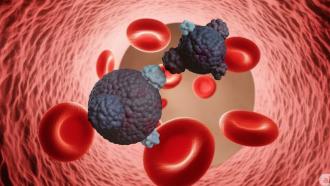Photo: Siddharth Kankaria / Research Matters
Tumors are often linked to cancer when they become malignant and start to spread. Doctors and researchers throughout the world are continuously seeking better ways to diagnose and treat tumors early on, thus preventing severe damage. In a rare interdisciplinary study, engineers from the Indian Institute of Science, Bangalore, have stepped up to help doctors in treating tumors. Prof. Radhakant Padhi from the Department of Aerospace Engineering and his team has designed an automation tool for slow and controlled drug release. It is an intelligent feedback algorithm that can be embedded in a micro-controller and effective in treating solid tumors with minimal side effects.
This study is probably one of the very few where aerospace engineers and computer scientists have come together to solve a difficult biomedical problem. “Aerospace systems call for extremely time critical control systems. The medical problem of treating tumors can also be identified as a control system problem. Its solution calls for the use of control systems principles”, says Prof. Padhi. However, there are two key differences between them – first, the control system needs more precision and accuracy to just treat the disease and not cause too much of side-effects and second, control inputs are always one-sided, i.e. one can always administer the drug into the body, but can’t take it away from it. “These two critical aspects make this field interesting and fascinating, yet quite challenging”, comments Prof. Padhi on his interest in this field of study.
A control system takes dynamically changing inputs based on the current state of the system. Treating a tumor can be compared to a control system where the amount of drug to use and its dispense frequency – the inputs - depend on the tumor size, the density of tumor cells, the number of healthy cells around it – the current state. The diffusion behaviour of the drug inside the tissue is a secondary parameter to consider.
The new automated therapy model designed at IISc is expected to be extremely useful in the treatment of localised solid tumors where small doses of the anti-cancer drug ensures low toxicity level and hence kills fewer healthy cells. It uses an automated treatment system that has an array of catheters or micro-needles and a computer controls and evaluates how much drug is to be dispensed and at what frequency. Since the system can monitor high accuracy of drug delivery and frequency, it can better benefit the treatment if the drug amount and the duration between the doses are low.
Earlier attempts to model automated systems for tumor treatments assumed that the drug is dispensed in a spatially continuous manner throughout the tumor volume, which is practically infeasible. Some used approximate models that required a considerable computational effort. The solution proposed by Prof. Padhi and his team considers the impracticality of continuous delivery of drug and hence, their model assumes that the drug is dispensed through an array of needles. Due to the closed form nature of the solution, the computation effort involved here is quite minimum and hence it can be easily implemented using modest hardware (typically a small wearable embedded platform). However, due to criticality of the problem, Prof. Padhi still recommends that an oncologist periodically monitors the progress of treatment and intervenes if necessary.
To test the accuracy of the proposed model, the researchers simulated a three-dimensional model of a brain tumor with cancer dynamics in a spheroid of 20mm diameter. This was chosen as an extreme case based on information reported in prior publications “For the success of the proposed autonomous drug-delivery approach, it is important to correctly model the spatio-temporal dynamics of the tumor as well as its interaction with the drug, which has been borrowed from a prior publication by established authors”, says Prof. Padhi.
Using computer simulations, the researchers experimented with various dosages and frequencies of the drug that could destroy the tumor. In the proposed feedback control synthesis algorithm, the drug dosage automatically gets adjusted with time, based on the rate of the decay of the tumor and the other parameters of the tumor dynamics. This ensures a continuous reduction in the tumour size. In their simulations, it was observed that after 40 days of treatment, the tumor density reduced by 87%, thus promising the ability of the model in annihilating tumors and its use in cancer therapy. The time of treatment is a tuning parameter, which can be varied in the algorithm in future.
“The proposed solution is futuristic and lot of things need to catch up before our research can be applied in practice”, says Prof. Padhi. “It assumes two important inputs, the tumor density and normal cell density. The techniques to accurately evaluate these values in real time need to evolve. We also need to address the robustness of the control law applied here, especially to variations in the input and model parameters”, he adds. Some of the ongoing work deals with model improvements using adaptive control ideas to make the automated therapy operate in a customized manner. The team is also looking at collaborative opportunities for integrating the proposed controller with an appropriate imaging technique to make this into a reality.

























